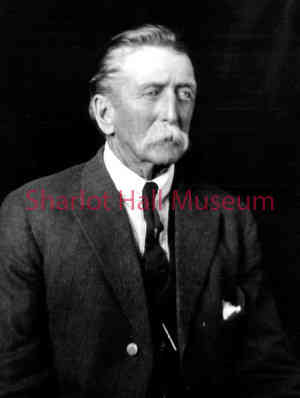By Marjory J. Sente
Martha Burton Woodhead Williamson, better known as Mrs. M. Burton Williamson, was born in England in 1843. She came to America the next year with her parents and lived in the Midwest. Well educated, she became a newspaper reporter, and in 1882, the associate editor of the Terre Haute Enterprise in Indiana.
In 1887 the Williamson family moved to Los Angeles, where Martha became involved in education, natural science, history and women’s rights. A prolific writer and scholar, she was a member of the Southern California Press Association. Her involvement with this organization led to her trip to the Grand Canyon.
She was one of at least three women traveling by train without a male escort on the Southern California Press Association’s June 1895 trip to Flagstaff, Arizona for the group’s annual meeting. They had a full agenda, including visiting cliff dwellings, the ruins of ancient caves in the area and the Grand Canyon.
A trip to the Grand Canyon at that time was no small undertaking. The April 17, 1895 Arizona Weekly Journal-Miner reported, “L.H. Tolfree, proprietor of the new hotel at the Grand Canyon of the Colorado, is making extensive preparations to entertain the members of the Southern California Press Association, who have arranged to visit the greatest wonder of the world next June.” The article also noted that J.W. Thurber’s stages would be transporting the approximately 60 tourists from Flagstaff to the Grand Canyon, a 24 to 26 hour round trip.
 Martha wrote, “On a day in June in 1895, a large party of Californians started from Flagstaff to the canyon. We occupied three large stages, some of the party being on the outside with the driver. A stage ride that occupies something like twelve or thirteen hours, may seem a tedious journey, but such did not prove the case.” She talked about the beautiful scenery and the relays where fresh horses were picked up and passengers could stretch and rest.
Martha wrote, “On a day in June in 1895, a large party of Californians started from Flagstaff to the canyon. We occupied three large stages, some of the party being on the outside with the driver. A stage ride that occupies something like twelve or thirteen hours, may seem a tedious journey, but such did not prove the case.” She talked about the beautiful scenery and the relays where fresh horses were picked up and passengers could stretch and rest.
At their lunch stop at a half-way house, their hostess (who was the cook, waitress and pot washer) was observant and helped to keep Martha safe. Martha wrote “But, amid all her hurry of serving a party of almost twenty-five, including the three drivers, the hostess had noticed a bunch of green pods, spotted with brown, that was fastened in lieu of a bouquet in front of my jacket. These pods, gathered because they looked good along the wayside, she declared were the ‘locoweed’ (Astragalus) considered ‘dangerous for man or beast, especially horses, to eat,’ so in a few moments I had thrown the decorative pods into the stove.”
The journey continued and by twilight they reached Tolfree’s hotel, previously called Hance’s Camp, near the edge of the South Rim. She recorded, “At nine o’clock as a lower grade was reached the Hotel with its many lights suddenly appeared. The hotel comprised a group of white tents, seventeen in number, including one long dining tent and a little log cabin, where we all stopped to register, formed a romantic picture nestled in a little pine covered glen between the hills. Below these hills, not more than three hundred feet away was the Grand Canyon.”
Next week, learn more about Martha’s visit to the Grand Canyon.
“Days Past” is a collaborative project of the Sharlot Hall Museum and the Prescott Corral of Westerners International (www.prescottcorral.org). This and other Days Past articles are also available at archives.sharlothallmuseum.org/articles/days-past-articles/1 The public is encouraged to submit proposed articles and inquiries to dayspast@sharlothallmuseum.org Please contact SHM Research Center reference desk at 928-277-2003, or via email at archivesrequest@sharlothallmuseum.org for information or assistance with photo requests.


